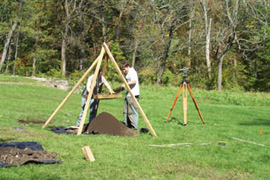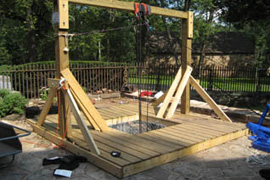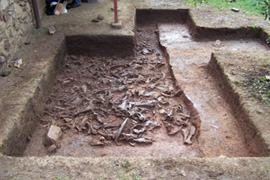Archaeological Excavations 2006
Archaeological Excavations 2006
The 2006 field season centered on three tasks: testing previously unexplored sections of the core area of the property, excavating the well located in front of the Stiegel mansion, and excavating the large midden feature discovered behind the Stiegel mansion adjacent to the Hessian barracks. Testing was begun during the summer of 2006, while the well project and the midden excavation were completed during the Fall of 2006 during the Millersville Archaeological Field School.
 |
| Field school students screening soil from test units in the core area of Elizabeth Furnace. |
One of the overarching project goals at Elizabeth is a thorough testing of potentially archaeologically significant areas in the core of Elizabeth Furnace village. During 2006, several areas were tested, the preferred methodology being excavation of 3' x 3' excavation units, aligned to our site grid, and dispersed geographically so that maximum coverage of the site was achieved. The irregularity of the locations of buildings and numerous trees growing on the property precluded any standardized testing interval being used, and units were sited based primarily on the availability of open ground. Testing was conducted in five areas of the property, and revealed widespread subsurface disturbance since the 18th century. The yard area to behind the Coleman and Stiegel mansions (to the west) was tested using 3' x 3' and 5' x 5' units. This testing identified the presence of the bone midden, discussed later. Additional testing to the South of the Coleman mansion and to the east of the Huber house revealed no intact deposits dating to the 18th century, and a widespread near-surface disturbance of soils layers, as 18th-century ceramics were commonly found in context with mid-20th century items. Test units in the location of the original store, approximately 250' east of the Coleman mansion, revealed that 20th-century grading activity had stripped the deposits in this area down to subsoil, and a five foot deep layer of cullet (a glassy waste product from the furnace) had been graded over the top of the area. Finally, the ground in front of the Hessian barracks (to the north of the building) was found also to have been disturbed.
 |
| The depth of the well was near 45ft, which meant that the only way down was by rope. This well head was constructed to safely raise and lower people and equipment in and out of the well. |
The well excavation was initiated by the discovery that a concrete cap sealed what appeared to be an old, dry-lain rock well just 20 feet beyond the front door of the Stiegel mansion. The possibility that this well dated to the 18th-century led project investigators to undertake excavation, despite the fact that the well was very deep, with archaeological sediments starting at a depth of 40 feet below ground level. Additionally, it was still an active well at the time of excavation, with a water column more than 23 feet high, containing an estimated 3,300 gallons of water within the well-shaft. The seepage rate of the well was estimated at around 50 gallons per hour, so after a two-day hiatus from the site, the well would have filled with roughly 15 feet of water. The technical problems that had to be overcome to conduct this excavation led to the development of several innovative approaches to excavation, which will be the subject of a forthcoming journal article. It will suffice to say that our approach was highly successful in overcoming these technical difficulties, but the well wound up dating to the late 19th-century, much to our disappointment.
 |
| This bone midden is nearly 10ft wide and more than 20ft long. This bone midden is located behind the Hessian Barracks and the Summer Kitchen. The fact that the bones were cracked and not butched indicates that the cuts of meat were boiled in stews, common practice in communal food production. |
The final area investigated during 2006 was a midden feature discovered adjacent to the Hessian barracks and to the rear of the Stiegel mansion. This feature proved to be an exceptionally rich bone midden, filled with the discard from food production in the summer kitchen. An estimated 500 individual bones were uncovered in-situ, providing archaeologists with an invaluable view of foodways and diet at this furnace during the late 18th and early 19th centuries. Many of the bones showed fractures indicating that they were deliberately shattered to open the marrow, and we believe that this is an indication they were being used as soup bones. It appears that a favored way of feeding furnace workers was with industrial-sized meat stews, and that many of these bones represent the remnants of such stews. The assemblage contained almost exclusively cow and pig bones, and further analysis will be conducted to determine the quality and cuts of meat used. Initial study suggests that many low-quality pieces were used, as jawbones and pelvises were ubiquitous throughout the assemblage. Artifact dates at the base of the layer, including English white salt-glazed creamware ceramics, suggest an initial date for the pit of around 1760-1770, while the top of the layer contained a few scattered fragments of Whiteware, indicating that the pit lay open until at least 1830.